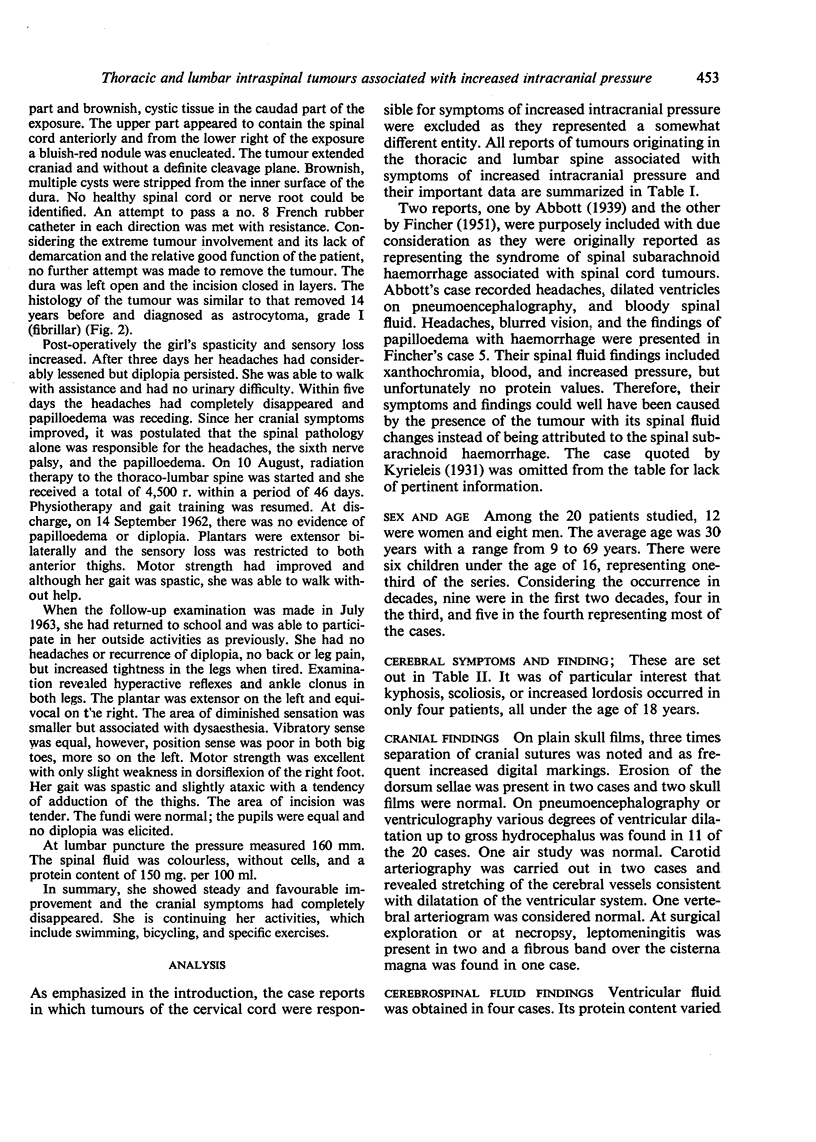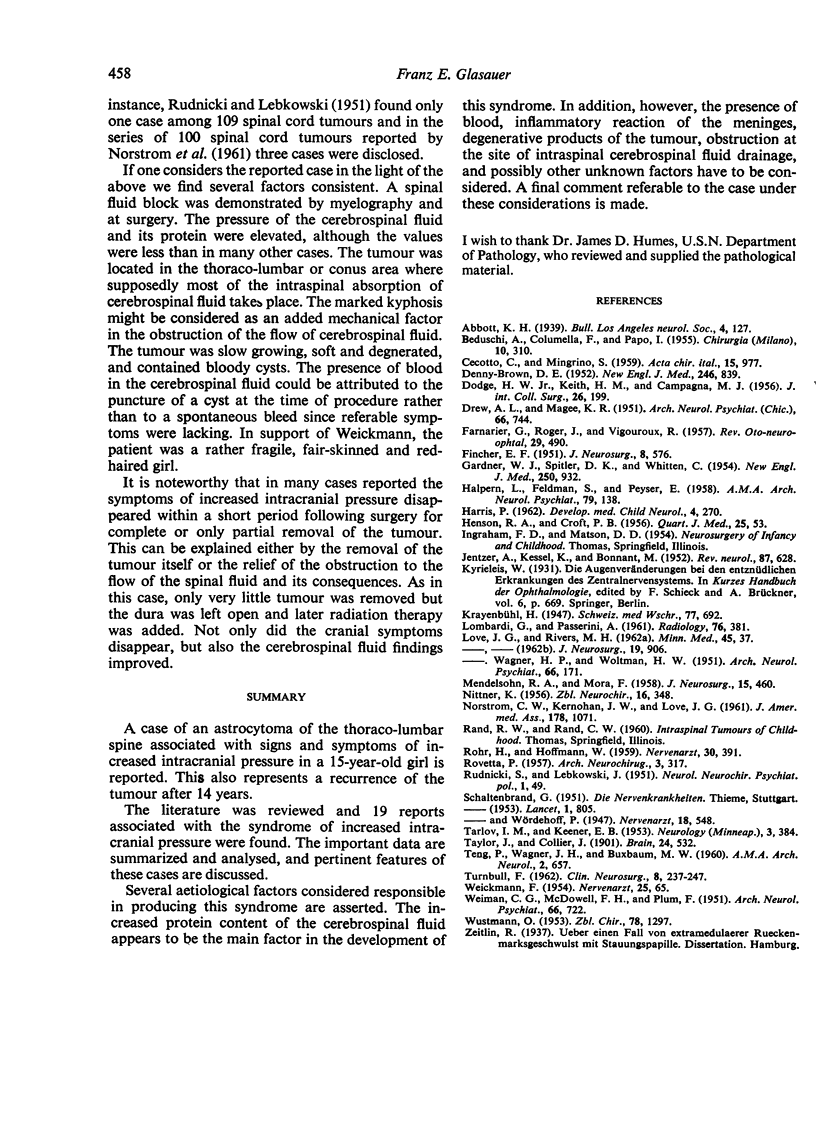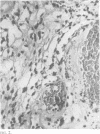Full text
PDF







Images in this article
Selected References
These references are in PubMed. This may not be the complete list of references from this article.
- CAMPAGNA M. J., DODGE H. W., Jr, KEITH H. M. Intraspinal tumors in infants and children. J Int Coll Surg. 1956 Aug;26(2):199–215. [PubMed] [Google Scholar]
- CECOTTO C., MINGRINO S. [Tumor of the conus and cauda with intracranial hypertension]. Acta Chir Ital. 1959 Nov-Dec;15:977–988. [PubMed] [Google Scholar]
- DENNY-BROWN D. E. The changing pattern of neurologic medicine. N Engl J Med. 1952 May 29;246(22):839–846. doi: 10.1056/NEJM195205292462201. [DOI] [PubMed] [Google Scholar]
- DREW A. L., MAGEE K. R. Papilledema in the Guillain-Barré syndrome. AMA Arch Neurol Psychiatry. 1951 Dec;66(6):744–751. doi: 10.1001/archneurpsyc.1951.02320120077010. [DOI] [PubMed] [Google Scholar]
- FARNARIER G., ROGER J., VIGOUROUX R. Localisation médullaire d'un médulloblastome avec syndrome d'hypertension intracranienne. Rev Otoneuroophtalmol. 1957;29(8):490–494. [PubMed] [Google Scholar]
- FINCHER E. F. Spontaneous subarachnoid hemorrhage in intradural tumors of the lumbar sac; a clinical syndrome. J Neurosurg. 1951 Nov;8(6):576–584. doi: 10.3171/jns.1951.8.6.0576. [DOI] [PubMed] [Google Scholar]
- GARDNER W. J., SPITLER D. K., WHITTEN C. Increased intracranial pressure caused by increased protein content in the cerebrospinal fluid; an explanation of papilledema in certain cases of small intracranial and intraspinal tumors, and in the Guillain-Barre syndrome. N Engl J Med. 1954 Jun 3;250(22):932–936. doi: 10.1056/NEJM195406032502202. [DOI] [PubMed] [Google Scholar]
- HALPERN L., FELDMAN S., PEYSER E. Subarachnoid hemorrhage with papilledema due to spinal neurofibroma. AMA Arch Neurol Psychiatry. 1958 Feb;79(2):138–141. doi: 10.1001/archneurpsyc.1958.02340020018004. [DOI] [PubMed] [Google Scholar]
- HARRIS P. Chronic progressive communicating hydrocephalus due to protein transudates from brain and spinal tumours. Dev Med Child Neurol. 1962 Jun;4:270–278. doi: 10.1111/j.1469-8749.1962.tb03161.x. [DOI] [PubMed] [Google Scholar]
- HENSON R. A., CROFT P. B. Spontaneous spinal subarachnoid haemorrhage. Q J Med. 1956 Jan;25(97):53–66. [PubMed] [Google Scholar]
- JENTZER A., KESSEL K., BONNANT M. Tumeur de la queue de cheval avec stase papillaire. Rev Neurol (Paris) 1952;87(6):628–632. [PubMed] [Google Scholar]
- LOMBARDI G., PASSERINI A. Spinal cord tumors. Radiology. 1961 Mar;76:381–392. doi: 10.1148/76.3.381. [DOI] [PubMed] [Google Scholar]
- LOVE J. G., RIVERS M. H. Value of spinal fluid protein in intraspinal tumors. Minn Med. 1962 Jan;45:37–40. [PubMed] [Google Scholar]
- LOVE J. G., WAGENER H. P., WOLTMAN H. W. Tumors of the spinal cord associated with choking of the optic disks. AMA Arch Neurol Psychiatry. 1951 Aug;66(2):171–177. doi: 10.1001/archneurpsyc.1951.02320080055005. [DOI] [PubMed] [Google Scholar]
- MENDELSOHN R. A., MORA F. Spontaneous subarachnoid hemorrhage caused by ependymoma of filum terminale. J Neurosurg. 1958 Jul;15(4):460–463. doi: 10.3171/jns.1958.15.4.0460. [DOI] [PubMed] [Google Scholar]
- NITTNER K. Die raumbeschränkenden spinalen Prozesse im Kindes- und Jugendalter. Zentralbl Neurochir. 1956;16(6):348–352. [PubMed] [Google Scholar]
- NORSTROM C. W., KERNOHAN J. W., LOVE J. G. One hundred primary caudal tumors. JAMA. 1961 Dec 16;178:1071–1077. doi: 10.1001/jama.1961.03040500013003. [DOI] [PubMed] [Google Scholar]
- ROHR H., HOFFMANN W. [Spinal cord tumors with obstruction papilla]. Nervenarzt. 1959 Sep 20;30:391–396. [PubMed] [Google Scholar]
- TARLOV I. M., KEENER E. B. Subarachnoid hemorrhage and tumor implants from spinal sarcoma in an infant. Neurology. 1953 May;3(5):384–390. doi: 10.1212/wnl.3.5.384. [DOI] [PubMed] [Google Scholar]
- TENG P., WAGNER J. H., BUXBAUM M. W. Giant ependymoma of the spinal cord associated with papilledema. Review of literature and report of a case. Arch Neurol. 1960 Jun;2:657–662. doi: 10.1001/archneur.1960.03840120063007. [DOI] [PubMed] [Google Scholar]
- TURNBULL F. Intramedullary tumors of the spinal cord. Clin Neurosurg. 1962;8:237–247. doi: 10.1093/neurosurgery/8.cn_suppl_1.237. [DOI] [PubMed] [Google Scholar]
- WEICKMANN F. Caudatumor und Stauungspapille, ein Beitrag zur Frage der Liquorzirkulation und Resorption. Nervenarzt. 1954 Feb 20;25(2):65–68. [PubMed] [Google Scholar]
- WEIMAN C. G., McDOWELL F. H., PLUM F. Papilledema in poliomyelitis. AMA Arch Neurol Psychiatry. 1951 Dec;66(6):722–727. doi: 10.1001/archneurpsyc.1951.02320120055007. [DOI] [PubMed] [Google Scholar]
- WUSTMANN O. Bewegungsvoränge im Liquorsystem; ein experimenteller Beitrag zur Vermeidung des postoperativen Hydrozephalus nach Meningozelenoperationen. Zentralbl Chir. 1953;78(31):1297–1301. [PubMed] [Google Scholar]




